Ayurveda Method Of Acupuncture -Marma Puncture
By Dr Raghuram Y.S. MD (Ay) & Dr Manasa, B.A.M.S
Marmas are vital points scattered all through the body. Each marma is formed by meeting of five structures at a point. They are
Mamsa – muscle tissue,
Sira – veins and arteries, nerves,
Snayu – ligaments and tendons, nerves,
Asthi – bones,
Sandhi – bony joints of the body
Marmas are not only the vital points but are also the points in the body where the life force (prana) resides.
Read – Marma Shaareera: Definition, Composition: Vital Points of The Body
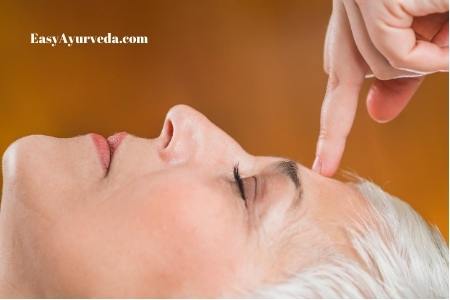
Table of Contents
Marma therapy
Marma therapy is therapeutic manipulation of marma points through therapies like massage. When these points are massaged, they are either stimulated or soothed depending on the purpose with which they are manipulated. Marmas are connected to energy centers of the body known as chakras through nadis.
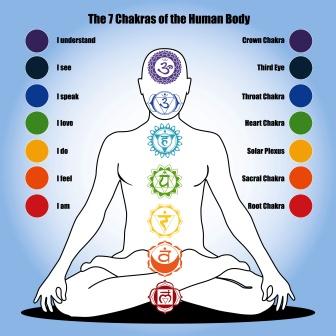
Chakras are spinning energy wheels in the line of the spine located from the tip of the spine to the crown of the head. They are 6 in number and are placed one above the other spaced from each other. The 7th one is called Sahasrara or 1000 petal chakra, located above the crown of the head.
Read – Chakra – Kundalini: Introduction, Meaning, Types, Location, Ayurveda View
Nadis are the energy channels which transfer the life force to every point of the body, from the chakras. Marma therapy manipulates the marmas and helps in transfer of the life force through the nadis. Therefore Marmas when manipulated through effective therapies enable physical, mental, sensual and spiritual healing.
‘The nadis – bio-energy channels penetrate the body from the soles of the feet to the crown of the head – in them is prana, the breath of life’ – says B.K.S. Iyengar
The marmas also connect to the important organs and vital structures of the interior of the body through the network of nadis and hence is vital in supplying life forces to all parts of the body.
Read – Prana, Tejas and Ojas – Subtle Forms of Tridoshas
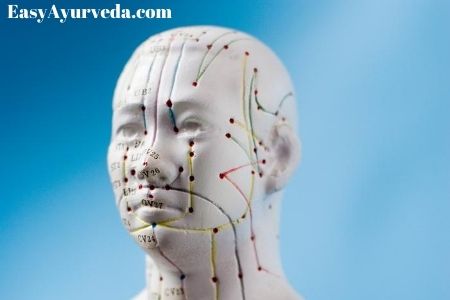
Marma Puncture – Ayurvedic Acupuncture
Marma puncture is the Ayurveda method of acupuncture. Marmapuncture is based on correcting energy imbalances in the body. This concept is developed on the foundation of explanation of 107 marmas explained by master Sushruta. It is a merger of Marma science and acupuncture.
This knowledge was not new for Ayurveda. Acupuncture is explained in the name of siravedhana, siravedha, suchi karma or suchi chikitsa. Sira vedha means vein puncture. Vein is also a type of marma. Suchi karma or chikitsa are therapies wherein suchi i.e. needles are used.
Drs. Joshi, Shah and Joshi tell – ‘In fact, this knowledge (acupuncture) already got passed to the nearby countries around India mainly during Buddha period. It is not a coincidence that almost all Buddhist countries have this knowledge and it is the Indian fortune that the origin of this knowledge is from India’
Says Prof. Dr H.S. Sharma, Ex Dean, Gujarat University, India – ‘Acupuncture, as we understand it today is one of the components of age-old Shalya Chikitsa and is the Indian study of the Dhanvantari School.’
In ancient times of Ayurveda it was known that certain vital points on the body known as marmas which when massaged, punctured, heated or burned relieved pain or had a beneficial effect on treating certain disorders.
Read – History of Acupuncture Treatment
If the acupuncture needles are inserted at various marma points, prana travels along these pathways. It was found that stimulation of these points would possibly influence the function of particular internal organs connected to these marma points through the energy channels called nadis. Such points were codified and charted according to the organ over which it was observed they had an influence. The channels were formed by connecting the points together with similar therapeutic properties. This would create an interwoven network through which prana and blood is transported to every part of the body.
When the life energy i.e. prana gets stagnated or imbalanced in these energy channels diseases are manifested. By needling the relevant energy points, the flow of energy can be restored and the health re-established. Thus, through marmapuncture prana si directed to remove blockages from the nadis and enable free flow of life energy throughout the body. Marmapuncture has deep relaxing effect. It enhances the immunity and heals the system. It restores homeostasis in your body.
Read – Importance Of Marma: Need for study
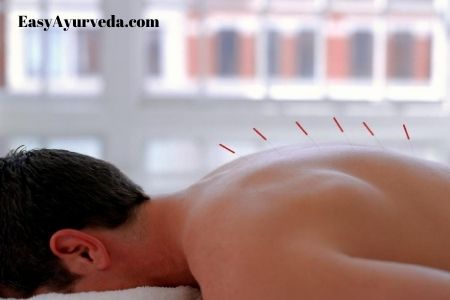
Benefits of Marmapuncture
It is beneficial in treating many diseases.
- Low immunity
- Low energy
- Digestive disorders – IBS, constipation, heartburn etc
- Cold, flu, hay fever
- Insomnia
- Migraine, headaches
- Low back pain
- Skin disorders
- Sciatica
- Neck pain and stiffness
- Shoulder pain
- Edema
- Fertility disorders
- Menopause and related disorders in women (read more)
Works related to Marmapuncture
Ayurvedic researchers (Prof. Dr. Binod K. Joshi et al), using the information of Marma from Sushruta Samhita has designed a special type of therapy known as Marma puncture. This is also called Ayurveda acupuncture.
Principle – In reviewing of the treatise, evidence was found showing that the marmas correspond precisely with traditional acupuncture points used to treat the vital organs and that the dhamanis and siras (blood vessels) depict meridians and channels that aid in the flow of qi. Against the conventional theory of dhamanis and siras being considered as arteries and veins, this theory considers them as the channels and meridians controlling the vital energy flow. This makes Sushruta Samhita as the base of acupuncture.
Foundation – Marmapuncture is attuned to the same concepts and diagnosis and treatment found in the other Ayurvedic modalities. Traditional marmapuncturist will often utilize marma massage, heat therapy (Agni karma) and Prana therapy (Prana Chikitsa) in conjunction with Marmapuncture. This means that these are all synergistic therapies reflecting the core of Ayurveda.
Modern research demonstrates that marmas are acupuncture points which have been needled for thousands of years without lethal effects. Lethal effects are caused by excessive and brutal force puncturing of the marma. Needling of the periphery of the marma will create a therapeutic effect. By needling marmas, the energy flow through these channels can be corrected and a balance brought to the human organism. This balance of energy equates with health.
Read – Introduction to Traditional Chinese Medicine
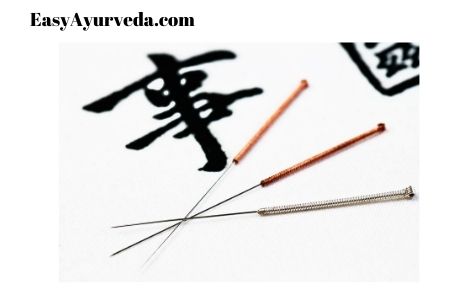
Origin of Acupuncture
Prof. Dr A. Jayasuriya et al. in 2001 found out the long history of native acupuncture practice in Sri Lanka. With the help of archeological evidences they also found out that this area (including nearby India, Kerala region) may have been the place of origin of acupuncture.
Recent archaeological evidences point towards practice of acupuncture both in India and Sri Lanka possibly stemming from Indus Valley Civilization and also from Vedic times.
Number of ancient needles used for acupuncture made of copper, bronze and iron was unearthed at Taxila University (Prof. Dr. C.L. Nagpal).
Acupuncture practice in India has been recorded even in Buddhist texts. Jivaka, the renowned Ayurveda surgeon of ancient times was considered as master acupuncture therapist. He is believed to have been born with an acupuncture needle in right hand and a drug container in the left hand. (Ref – Chikitsa Vidya).
Marmapuncture totally depends on the Ayurveda methods of diagnosis and treatment principles. The marmapuncturist will utilize marma massage, heat therapy i.e. agnikarma, and Prana therapy in conjunction with marmapuncture which are all part and parcel of Ayurveda.
Read – Marma Therapy Basics, Text Books, Spiritual Healing, Treatment Planning
Logic behind using Marmapuncture as a healing therapy
Ayurveda explains that the injury, including puncture of marmas will lead to many disorders. Therefore puncture of marmas was contraindicated. This stems back to the concept of surgery and injury to the marmas during wars would be treated by surgeons after their marmas had been subjected to trauma during fights. The concept of marmas was considered sacred and marma puncture was abstained. This probably was also a way of keeping the knowledge secret.
In perspective of contraindication, the definition of puncturing was that ‘the insertion of sharp objects in a forced or brutal way into the marma, for example, with a spear, arrow, knife etc will cause major trauma or death.’ Thus puncture with brutal force over marma should not be done.
The marmapuncture gives rise to controlled, minute trauma to the marmas. This minor puncturing will produce a stimulation which encourages the body into an action of self-repair. So, if the trauma is major, it kills the organism. If the trauma is medium, it inhibits the organism. If the trauma is minute, it stimulates the organism. This law is called hormesis in toxicology.
Sthapani i.e. forehead marma and Hridaya Marma i.e. heart marma are punctured by many practitioners. In spite of them being lethal marmas, they cause no serious complications with minute puncture.
Read – Hridaya Marma: Components, Location, Effect Of Injury
Some marmas like nabhi i.e. navel marma, sthanamula i.e. breast marmas and nila i.e. throat marmas are not directly punctured. Other marmas can be punctured at nearby points. Marmas located over sensitive organs and major arteries are generally avoided. Major marmas that directly relate to the chakras should be needled gently by rotating the needle as it is inserted. This may aggravate the balance of the subtle body.
Read – Nabhi Marma: Components, Location, Effect Of Injury
About marma puncture needles
An expert marmapuncturist uses least number of needles and induce great therapeutic effects. He may use 15 needles maximum for one client. The number of needles depends on the body type of the patient and differs for Vata, Pitta or Kapha body types. The needles should be very fine. The standard type i.e. 0.25mm x 25mm shall be used. The thicker needles will cause pain and aggravate Vata.
Needles are inserted into the marmas in a gentle and rhythmic way in accordance with qualities of Vata, Pitta or Kapha and the body type of the client. Marma puncture shall be done at the center of the marma to obtain most subtle effect. Needling anywhere near the area of marma too will give similar effect.
Read – Tridosha Theory in Ayurveda
Treatment
Marma puncture treatment shall be done after proper diagnosis of disease and its stages using all tools of Ayurveda diagnosis. The conditions of tissues, systems, organs, digestive capacity and ojas should be considered. The marma point is considered for treatment to address the factors which are out of balance.
Doshas are mainly considered. Appropriate points for doshas and dosha balance are considered. If the mind healing needs to be done, the mind qualities i.e. sattva, rajas and tamas are considered. Appropriate marma points corresponding to these qualities and to balance them are taken into consideration. Treatment includes correctly adjusting the sub doshas in appropriate direction, mainly Apana, Udana, Samana, Vyana and Prana Vayus. This is because the marmas are rich in Prana which represents Vayu. Marmas also comprise of tejas and ojas, subtle representatives of pitta and kapha doshas respectively. Therefore pitta and kapha subtypes too may be considered.
Read – Vata Dosha – Introduction, 40 Things To Know
The final prescription of marma points may contain number of points that are duplicated because the same marma may have a multiple of qualities or effects on multi-systems related to those marmas. The effect of therapy is synergistic. The effect is magnified because of the combination and not just because of the selection of individual points.
The materials used for needling have their own qualities and effects on the doshas. Examples – silver needles may aggravate vata or kapha on a subtle level. Gold may aggravate pitta on a subtle level. The correct material for a person’s body type will enhance the therapy, especially on a subtle level and also to treat psychological or emotional imbalances.
Insertion time also depends on body type. Vata clients require less time than pitta or kapha. Kapha people require most time.
The impact also depends on method of use of needles. Strong and erratic actions will aggravate Vata but might help to pacify kapha disorder. Smooth and slow actions may not help a kapha person and in fact may aggravate kapha.
Read – Classification Of Marma Based On Effect Of Injury
Needling effect according to doshas
| Sl No | Requirement for needling | Vata | Pitta | Kapha |
| 1 | Depth of insertion into the marma | Shallow | Medium | Deeper |
| 2 | Number of needles to be used | Minimum | Medium | Most |
| 3 | Needle material | Gold or Silver | Silver | Gold |
| 4 | Action / Insertion | Gentle Rhythmic | Medium Rhythmic | Erratic Strong |
| 5 | Needling time | 15-30 minutes | 20-40 minutes | 40-60 minutes |
| 6 | Electric pulse | Slow, rhythmic, less intense | Medium, regular, rhythmic | Intense, fast, erratic |
| 7 | Heat application (agnikarma) | May require heat but nor excessive | Does not generally require heat | May require heat |
Marmas are therefore the energy wells connected with all parts and organs of the body through a meridian system of conduits known as nadis. The energy flow through these channels can be corrected and a balance induced in the human body by needling the marmas. This balance of energy brings in good balance of body-mind-sensual and spiritual health.
When particular marma is punctured or needled, marmapuncture cures by stimulating the body to heal rather than treating the disease. This is an important therapy which aims at balancing all levels of the Self and not just the physical level. This principle is termed as Akashic or Etheric Balancing wherein the marmas are used as tools for the body to balance its own bio-computer to achieve homeostasis.
Click to Consult Dr Raghuram Y.S. MD (Ayu) – Skype




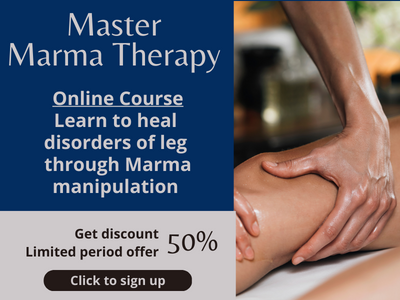






One comment
Vinod Shreni
Useful info.